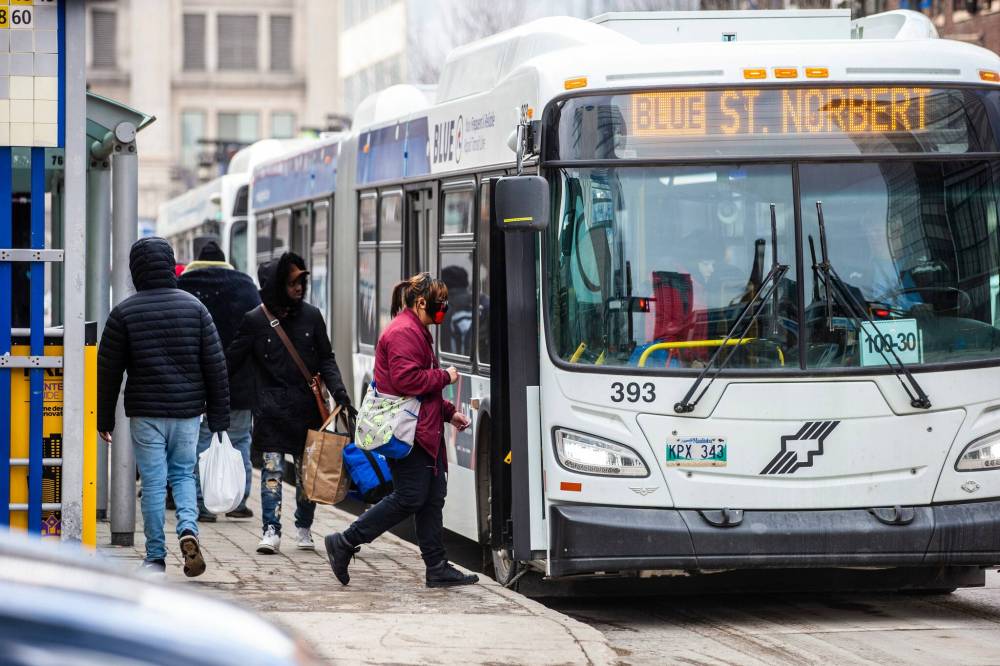Transit going in a new direction
Advertisement
Read this article for free:
or
Already have an account? Log in here »
To continue reading, please subscribe:
Monthly Digital Subscription
$0 for the first 4 weeks*
- Enjoy unlimited reading on winnipegfreepress.com
- Read the E-Edition, our digital replica newspaper
- Access News Break, our award-winning app
- Play interactive puzzles
*No charge for 4 weeks then price increases to the regular rate of $19.00 plus GST every four weeks. Offer available to new and qualified returning subscribers only. Cancel any time.
Monthly Digital Subscription
$4.75/week*
- Enjoy unlimited reading on winnipegfreepress.com
- Read the E-Edition, our digital replica newspaper
- Access News Break, our award-winning app
- Play interactive puzzles
*Billed as $19 plus GST every four weeks. Cancel any time.
To continue reading, please subscribe:
Add Free Press access to your Brandon Sun subscription for only an additional
$1 for the first 4 weeks*
*Your next subscription payment will increase by $1.00 and you will be charged $16.99 plus GST for four weeks. After four weeks, your payment will increase to $23.99 plus GST every four weeks.
Read unlimited articles for free today:
or
Already have an account? Log in here »
Hey there, time traveller!
This article was published 13/06/2024 (528 days ago), so information in it may no longer be current.
It has been said, perhaps more often than warranted and with an extra dollop of vainglorious self-deprecation, that Winnipeggers are notoriously resistant to change.
In truth, reluctance to let go of the familiar and embrace the new is a fundamental aspect of the human condition. The oft-repeated reference to being in one’s “comfort zone,” after all, does not refer to confronting unfamiliarity or facing potential risk.
Resisting change is not something folks hereabouts do with more persistence or passion than people in other places.

MIKAELA MACKENZIE / WINNIPEG FREE PRESS
Winnipeg Transit buses on Graham Avenue.
But referring to ourselves as “notoriously” resistant to change makes us feel somehow special — in a manner not completely dissimilar to how many among us tout our city, with an odd mix of chagrin and perverse pride, as the murder capital of Canada and/or the Slurpee capital of the entire world.
The cultural obstinacy that resides here dwells elsewhere as well. We are not unique in our aversion to alteration.
That said, however, there are movements afoot that will soon offer a significant and very local test of Winnipeggers’ ability to adjust to massive change. Slightly more than a year from now — on June 29, 2025, to be precise — Winnipeg Transit will embark on the most dramatic reconfiguration in its 140-year history.
Virtually every route in the city — there are currently 87, traversing nearly 5,200 stops throughout the metropolitan area — will be affected as the public-transit utility switches from its long-entrenched collection of downtown-directed lines to a more strategic “spine-feeder” system that employs primary and feeder networks.
In the current arrangement, nearly all Transit routes make their way to, or through, downtown. The new plan will see primary routes — including the rapid-transit corridor to the University of Manitoba and on other major thoroughfares such as Nairn Avenue, McPhillips Street and Portage Avenue — focused on ferrying passengers to and from downtown, while buses on regional “feeder” routes will deliver riders to primary routes and also get them to and from community amenites in the areas in which they reside.
The intention of the master plan is essentially to double the number of people who are in walking distance of frequent transit service, with a bus arriving at least every 10 minutes during rush hour on the most frequent routes.
Not surprisingly, resistance to these changes has arrived more swiftly and predictably than a Winnipeg Transit bus on one of the system’s current routes. At city hall on Tuesday, several Wolseley residents asked the city to exclude their neighbourhood from the scheduled shift, citing concerns about disruption of Wolseley’s reduced-speed greenway plan, safety of pedestrians and cyclists during peak traffic times, and increased walking distances to bus stops after the No. 10 route is eliminated in favour of a new No. 28 bus.
Further amendments to the overhaul might be considered once the new routing system is given a (literal) test drive, but the bottom line is that the changes — in Wolseley and elsewhere — will ultimately make Winnipeg Transit more efficient and timely and, hopefully, attractive to more Winnipeggers as a legitimate transportation option.
According to Brian Pincott of the advocacy group Functional Transit Winnipeg, the massive change “is essentially taking the system we have right now and blowing it up and starting over again, (which) is exactly what needs to be done. It is focused on getting people from where they are to where they want to go more efficiently.”
Change is difficult, especially at first. But as even those stereotypical Winnipeggers who staunchly opposed such disruptive developments as The Forks and the city’s downtown arena complex would concede, sometimes change really is for the better.


